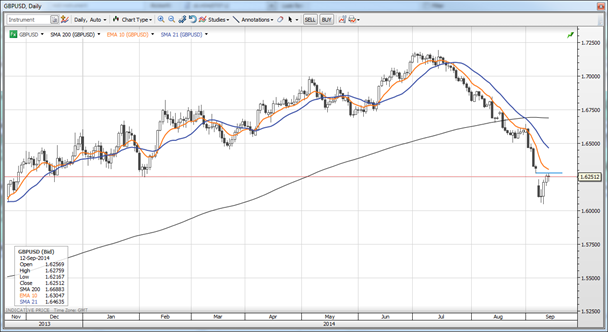Yesterday saw an extension of the themes that developed earlier this week, with a notably weak AUD and CAD, JPY dipping further, the euro resilient after the recent plunge on the shifting focus against commodity currencies (new multi-year lows in some commodities indices), which is squeezing euro carry trades. Meanwhile, the pound was pushed back lower after closing the gap against the US dollar.
The European Central Bank’s governor, Mario Draghi, was out yesterday touting the potential of the new policy mix to grow the ECB’s balance sheet to where it was in 2012. That’s a lot of buying, as the balance sheet now stands around EUR 2 trillion vs. well over 3 trn at its largest. The market was unimpressed with this dose of rhetoric, suggesting the euro could remain resilient as speculators are so heavily positioned short already.
Interestingly, ECB’s vice president, Vitor Constancio, claimed that the ECB has the legal right to buy government bonds in the secondary market.
Note another big year-on-year drop in New Zealand housing activity as sales dropped 16% year-on-year. The higher rate environment is clearly slowing activity. Price falls will inevitably follow and are likely to lead to an increasingly dovish RBNZ. AUD has begun outpacing NZD to the downside, though I would expect the potential for that to extend is limited.
Chart: GBPUSD
The market is rapidly pricing out the likelihood of a Yes vote at next Thursday’s Scottish independence referendum after the latest poll results, and GBPUSD has found resistance at the obvious first resistance – the gap that developed over the weekend after the shock poll showing the Yes vote gaining momentum. That level comes in around 1.6275 and now almost coincides with the 10-day EMA (orange line), which is often a good trend indicator.

Next week’s FOMC meeting
We’re building a considerable deal of expectation into next week’s Federal Open Market Committee meeting, though most of that anticipation seems evident in the currency market, which has been the quietest of markets (earlier this year, at least). A barometer like the June 2015 Fed Funds future is lower, meaning anticipating an earlier hike than previously, but we’re talking a matter of a few bps over the last few weeks, and we’re still in the middle of the range stretching back to the beginning of this year.
Even further out the curve, looking at perhaps Dec 2016 EuroDollar STIR futures, we can see a similar pattern – recent anticipation of more hawkish guidance. This is still not to a degree that has pushed expectations out of the range established in prior months, though we’re getting a bit closer to that development the further out the curve you go. In any case, it is clear that the Fed's chair, Janet Yellen, will have to deliver some degree of hawkishness to keep the USD bull on track.
Another factor that may be supporting the US dollar is the weak global oil price, where exporters will have fewer reserve dollars to diversify into other currencies. NOK and CAD and even MXN have been weaker on the plunge in oil prices over the last several days.
Looking ahead
Watch for data today to test the US dollar rally – retail sales are an important indicator. It’s time for a strong reading in the data series if the recovery story is to maintain a head of steam.
We have a Swedish election on tap over the weekend, with a political leadership change expected from the right to the left, though with questionable consequences for SEK.
The old knee-jerk trade is to believe that a more liberal government such as Prime Minister John Fredrik Reinfeldt's is more positive for business and therefore for the currency, while a more left-leaning government is bad. But I suspect that macro data, general market themes and signals from Sweden's central bank Riksbank will far outweigh any new Swedish government policy implications from a change of leadership.
Pressure in EURSEK does appear higher for now and the pair could spill through to 9.30+ if the current punishing of smaller currencies continues in the days ahead.
Economic data highlights
- New Zealand Aug. BusinessNZ Manufacturing PMI (2230)
- New Zealand Aug. REINZ House Price Index rose +1.1% MoM vs. -0.7% in Jul
- New Zealand Aug. REINZ House Sales fell -16.3% YoY vs. -13.0% in Jul
Upcoming economic calendar highlights (all times GMT)
- Euro Zone ECB’s Weidmann, Bundesbank’s Boehmler to Speak (0800)
- Euro Zone Jul. Industrial Production (0900)
- Euro Zone Q2 Employment (0900)
- US Aug. Retail Sales (1230)
- Canada Aug. Teranet/National Bank Home Price Index (1300)
- US Sep. Preliminary University of Michigan Confidence survey (1355)
- US Jul. Business Inventories (1400)
